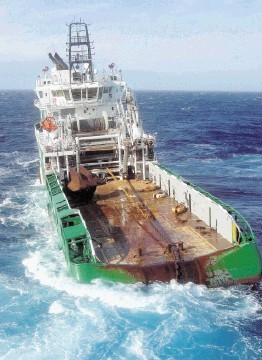
Potential warning signs in the lead up to the worst North Sea maritime disaster since Piper Alpha were not picked up on, according to one of the investigators.
The Bourbon Dolphin tragedy ten years ago resulted in the death of eight people, including a 14 -year-old boy, and resulted in sweeping reforms of marine safety regulations.
Five of the bodies were never recovered after the ship capsized while carrying out anchor handling duties in the Rosebank oil and gas field off Shetland.
It is the single greatest loss of life in a maritime incident in UK waters since the Piper Alpha disaster, the 1988 rig fire which claimed 167 lives.
Pinsent Masons partner Bruce Craig, who was part of the post-incident investigation team, gave a presentation on the accident at a meeting of the Marine Safety Forum at Aberdeen’s Beach Ballroom yesterday (THU).
During his talk, he revealed how the ship had rolled twice during early trials.
The crane was also not configured to carry out work for the full tonnage that it had been prescribed for and the vessel had arrived at launch 392 tonnes heavier than anticipated.
It was the smallest of four ships carrying out anchor handling duties at the field.
Two masters of the vessel both voiced concerns before the tragedy about the stability of the ship.
Mr Craig said: “Both the masters felt that the vessel felt less stable than they would have expected.
“The vessel was far, far heavier than they expected at launch. Nobody thought that this was an issue.
“If you put these various things together they clearly can, from looking back at the tragedy, can be seen as potential warning signs.
“But if they were warning signs they weren’t being picked up on.”
The anchor handling vessel “turned turtle” when an operation to shift the anchor of a drilling rig went wrong on April 12, 2007.
The ship ended up ‘off-track’ while trailing the anchor chain due to a strong current and other weather factors.
The engines then overheated, which was discovered post-incident, leading to a total power loss.
The anchor chain was then allowed to slide to the rear port side, in the hope it would bring the ship back on track.
However the sudden movement resulted in the ship capsizing in a matter of seconds.
It remained attached to rig anchor line however – resulting in an emergency downmanning of the drilling rig in case it collided.
The ship sank several days later after being cut free from the line.
Eight of the 15 Norwegian people on board died including the Master and his 14-year old son, who was on board for work experience during the Easter holidays.
An inquiry into the tragedy found safety failings by three firms – owner Bourbon Offshore, operator of the field Chevron and rig owner Transocean – were factors in the accident.
Bourbon Offshore was fined £500,000 in Norway because the company failed to give the ship’s new captain, Oddne Arve Remoy, 44, enough time to learn about the vessel, her crew and the complex operation.
He had only 90 minutes to take over following a crew change.